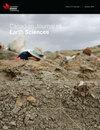Reinterpretation of a major terrane boundary in the northern Svalbard Caledonides based on metamorphic fingerprinting of rocks in northern Spitsbergen
IF 1.6
4区 地球科学
Q3 GEOSCIENCES, MULTIDISCIPLINARY
引用次数: 0
Abstract
Tectonic models for development of the Svalbard Caledonides depend on reliable assessment of the metamorphic evolution of the various basement provinces involved. The Mosselhalvøya Group (MG) and the Atomfjella Complex (AC) have previously been assigned to the Nordaustlandet and West Ny-Friesland terranes, respectively. New analytical data and petrographic observations indicate that both units experienced 2-stage metamorphism under similar pressure-temperature (P-T) conditions. Two stages of amphibolite facies metamorphism (M1 and M2) are clearly recorded by garnet and staurolite porphyroblast textures. The results of thermodynamic phase equilibrium modelling indicate that peak M2 metamorphism occurred at ~7-7.5 kbar and 590-600°C in both units. Zirconium-in-rutile trace element thermometry confirms the temperature estimates for M1 and M2 stages of metamorphism. Monazite chemical Th-U-Pb dates from the MG resolve a 2-stage garnet growth at 444 ± 7 Ma (M1) and 423 ± 6 Ma (M2). In contrast, monazite dated in the AC define a single age of 420 ± 4 Ma interpreted as M2 growth. We suggest M2 was coeval with early strike-slip motion along the Billefjorden Fault Zone, whereas M1 reflects initial tectonic burial of the studied units. The similarity in metamorphic history between the both units suggest that the boundary between them is a subordinate thrust fault within the Atomfjella thrust stack rather than a major boundary separating the Nordaustlandet and West Ny-Friesland terranes. The MG is included within West Ny-Friesland terrane and the tectonic boundary with the Nordaustlandet terrane is likely the Eolussletta Shear Zone.基于斯匹次卑尔根岛北部岩石的变质指纹,重新解释斯瓦尔巴群岛北部卡利多尼德的主要地界
斯瓦尔巴喀里多尼德发育的构造模式依赖于对所涉及的各个基底省的变质演化的可靠评估。Mosselhalvøya Group (MG)和Atomfjella Complex (AC)此前分别被分配到Nordaustlandet和West Ny-Friesland区块。新的分析资料和岩石学观察表明,两个单元在相似的压力-温度(P-T)条件下经历了2期变质作用。石榴石和橄榄石斑岩结构清楚地记录了角闪岩相变质作用的两个阶段(M1和M2)。热力学相平衡模拟结果表明,在~7 ~ 7.5 kbar和590 ~ 600℃的温度下,两个单元的M2变质作用均达到峰值。金红石中锆微量元素测温证实了变质作用M1和M2阶段的温度估计。单氮石化学Th-U-Pb数据来自MG,在444±7 Ma (M1)和423±6 Ma (M2)的两个阶段石榴石生长。相比之下,在AC中定年的独居石定义了420±4 Ma的单一年龄,解释为M2生长。我们认为M2与Billefjorden断裂带的早期走滑运动同时发生,而M1反映了研究单元的初始构造埋藏。两者变质史的相似性表明,它们之间的边界是阿托姆菲耶拉逆冲叠组内的次级逆冲断层,而不是分隔北达斯特兰地体和西纽弗里斯兰地体的主边界。MG被包括在西Ny-Friesland地体中,与nordastlandet地体的构造边界可能是Eolussletta剪切带。
本文章由计算机程序翻译,如有差异,请以英文原文为准。
求助全文
约1分钟内获得全文
求助全文
来源期刊

Canadian Journal of Earth Sciences
地学-地球科学综合
CiteScore
2.80
自引率
7.10%
发文量
66
审稿时长
6-12 weeks
期刊介绍:
The Canadian Journal of Earth Sciences reports current research in climate and environmental geoscience; geoarchaeology and forensic geoscience; geochronology and geochemistry; geophysics; GIS and geomatics; hydrology; mineralogy and petrology; mining and engineering geology; ore deposits and economic geology; paleontology, petroleum geology and basin analysis; physical geography and Quaternary geoscience; planetary geoscience; sedimentology and stratigraphy; soil sciences; and structural geology and tectonics. It also publishes special issues that focus on information and studies about a particular segment of earth sciences.
 求助内容:
求助内容: 应助结果提醒方式:
应助结果提醒方式:


